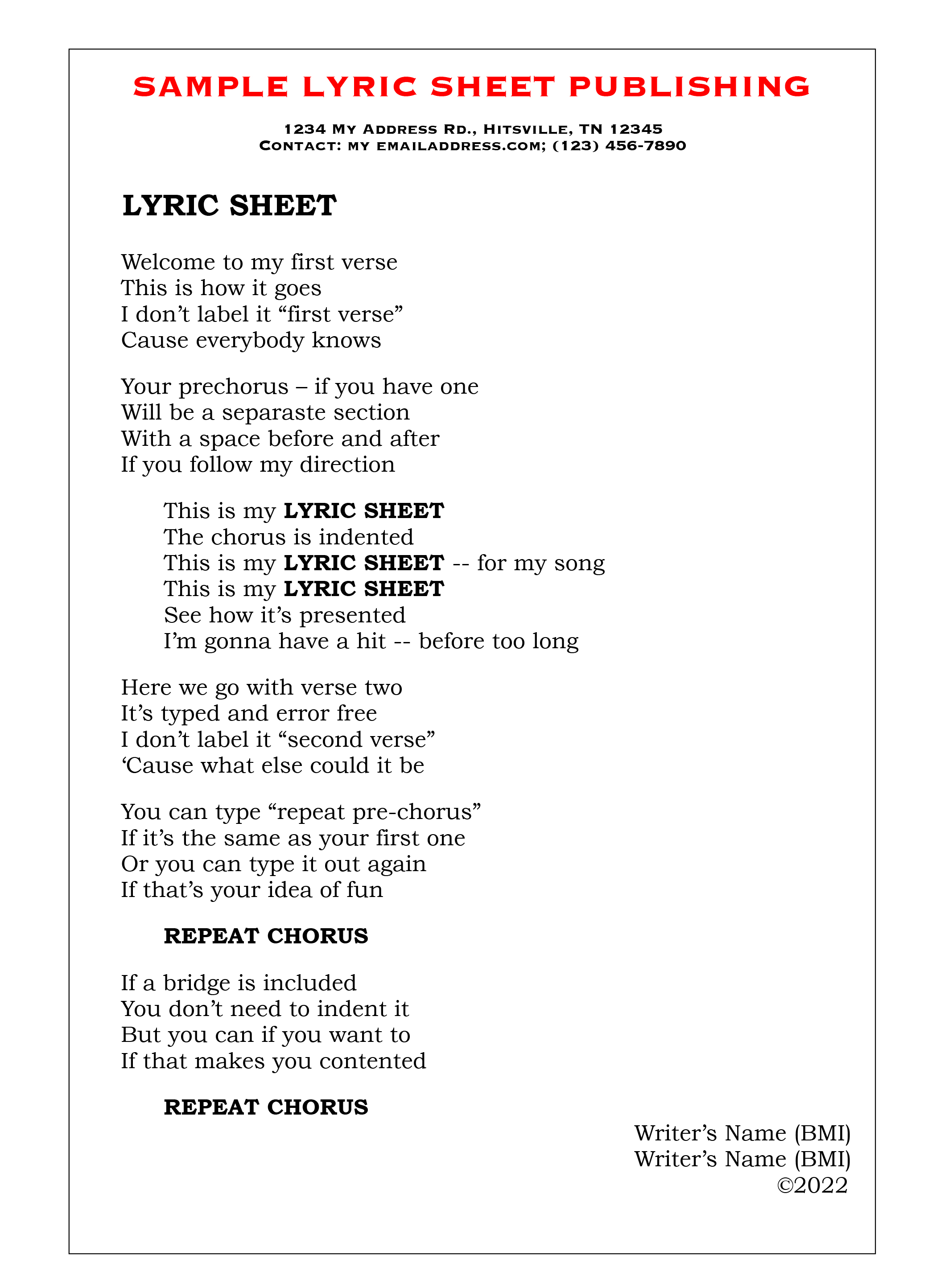How to Create the Perfect Lyric Sheet

When we present a song to a music industry professional, whether in person or via the internet, it is always a good idea to have a lyric sheet available. At a face-to-face meeting, ask whether the listener would like to follow along with a lyric sheet. When sending songs via the internet, include a lyric sheet for each song you send. These should be sent as attachments—not in the body of the email.
Your lyric sheet is one of the first elements that will allow a listener to assess you and your song. It is an opportunity to make a positive first impression, and while it might seem insignificant, failure to abide by the industry standard can be interpreted as a a sign that you are not a professional.
You’ve worked long and hard to make your song as strong as it can be. Let’s look at the elements you should—and should not—include on your lyric sheets.
- Never hand-write your lyric. Lyric sheets should be typed and error free.
- It is not appropriate to describe the song on your lyric sheet. For example, do not include information such as, “uptempo fun R&B song,” “slow sad country love song,” or “this song is for a pop artist.” Your listener should be able to discern these things when he or she listens.
- Do not include chords on the lyric sheet and do not provide a lead sheet. While I have been asked to provide a chord chart on a handful of occasions, it has only happened after my song has been selected to be recorded. I have never been asked to provide a lead sheet.
- Avoid incorporating drawings such as musical notes, flowers, or any other embellishments. Save your creativity for the songs. Create a document that looks professional, similar to something that might be sent on letterhead from an attorney’s office.
- Do not type the chorus lyric every time it appears unless there are changes in the various choruses. Instead, type “Repeat Chorus” each time the chorus occurs. If your song includes a prechorus—and that prechorus has the same lyric each time—you have the option of re-typing it or typing “Repeat Prechorus.”
- If your song is one of the typical structures (i.e., V-C-V-C-B-C) it should fit on one page. The exception is if your song is a rap song or a song that includes a rap. This would likely require one or more additional pages to contain the lyric. You can typically keep your lyric sheet to one page by typing it single spaced, using an 11- or 12-point font, and keeping the spaces between sections small.
- Avoid punctuation marks such as periods and exclamation points. Commas and question marks are fine, if needed.
- Include the writers’ names, PRO affiliation, and year of copyright registration. It is not appropriate to include the specific date of creation.
- Be sure to include your email address and phone number. A street address is optional.
- Do not include the tempo, beats per minute, or key.
- Separate the chorus by indenting it. You might choose to use a bold font for the entire chorus or only for the title. While a bold font is frequently used for the chorus (or the title) it is not mandatory.
- Do not label the individual sections (i.e., Verse 1, Verse 2, Chorus, Bridge).
- Do not include the names of the vocalist, musicians, or the studio where your song was recorded.
By using the sample lyric sheet (below) as a template you can be sure your lyric sheets represent you as a pro.

In summation, the perfect lyric sheet should consist of only the song’s lyric, the writers’ names and PRO affiliations, the year the copyright was registered, and contact information. Inclusion of additional information can be a red flag that the submission has not come from an industry professional.
Jason Blume is the author of 6 Steps to Songwriting Success, This Business of Songwriting, and Inside Songwriting (Billboard Books). His songs are on Grammy-nominated albums and have sold more than 50,000,000 copies. He has been a guest lecturer at the Liverpool Institute for Performing Arts (co-founded by Sir Paul McCartney) and at the Berklee School of Music, and has been interviewed as a songwriting expert for CNN, NPR, Rolling Stone magazine, and the New York Times. For information about his workshops, webinars, additional articles, and more, visit www.jasonblume.com.






Community
Connect with BMI & Professional Songwriters